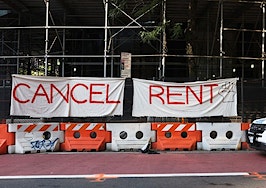The coronavirus pandemic did more than reveal the systemic issues within America’s health care system — it pulled the covers back on decades of discrimination and racism that undergird the real estate industry, including redlining and single-family zoning reform.
It also showed us the consequences of those policies in the disproportionate number of minority and low-income communities who have the most to lose if unemployment benefits and eviction moratoriums aren’t extended.
But 2020 also illuminated a way forward through conversations about anti-racism and biased business practices and policy changes, such as the National Association of Realtors’ code of ethics update, which can help correct years of intentional and unintentional wrongdoing.
Here’s a look back at the year’s most important housing equality and policy stories and what could be in store for 2021:
Redlining goes digital
In October, Redfin found itself in the hot seat after the National Fair Housing Alliance (NFHA) accused the company of redlining lower-income and majority-minority communities through the home price threshold for Redfin’s top-tier services, such as Redfin Concierge.
In a press release announcing the lawsuit against Redfin, the NFHA said a two-year investigation of Redfin’s business practices in Baltimore, Chicago, Detroit, Kansas City, Long Island, Louisville, Memphis, Milwaukee, Newark and Philadelphia revealed 50.79 percent of sellers in “predominately white ZIP codes” were eligible for Redfin’s premium services. Meanwhile, only 6.84 percent of sellers in “extremely non-white ZIP codes” were eligible for those same services.
For example, Redfin’s brokerage services in Chicago, which is 33.3 percent white, are only available to sellers with homes priced at $400,000 or more. However, 26 miles away in DuPage County, which is 66.3 percent white, Redfin’s brokerage services are available to sellers with homes valued as low as $275,000.
The trend held in each of the markets NFHA examined, with Redfin’s service minimums fluctuating by as much as $450,000 from ZIP code to ZIP code.

Lisa Rice
NFHA CEO Lisa Rice said the pricing disparity was an example of redlining, a federally mandated practice that prevented homeowners, homebuyers and renters in predominantly Black neighborhoods from accessing favorable mortgage rates, insurance, loans and other financial services. The federal government issued maps with red lines around these neighborhoods to signal the “riskiness” of lending in these areas, hence the term redlining.
The Fair Housing Act of 1968 made redlining as a federally mandated law illegal. However, the effects of redlining are still felt today by the lower home price appreciation trends in minority and majority-Black neighborhoods, stagnant homeownership growth among Black Americans, and disparities in securing mortgages and accurate appraisals.
“Redlining, and the residential segregation it causes, represents America’s oldest racist and discriminatory real estate policy,” Rice said. “The fact that these actions are still occurring, let alone by a major corporation, demonstrates why we need strong civil rights protections now more than ever.”
“Redfin’s policies redline communities of color and will further exacerbate the racial wealth and homeownership gaps,” Rice added. “We must ensure that all neighborhoods are treated fairly and have access to the full range of services provided by real estate companies.”

Glenn Kelman | Photo credit: Redfin
Redfin CEO Glenn Kelman vehemently denied NFHA’s redlining accusations while pointing to his and Redfin’s, stance on diversity, racism and discriminatory housing policies and practices (e.g., the movement to ban pocket listings). Instead, Kelman said the trend NFHA noticed is a result of Redfin’s atypical structure that classifies agents as W-2 employees instead of independent contractors.
“The challenge is that we don’t know how to sell the lowest-priced homes while paying our agents and other staff a living wage, with health insurance and other benefits,” Kelman said in a previous Inman article. “This is why Redfin agents aren’t always in low-priced neighborhoods. It’s why Redfin doesn’t serve many rural towns.”
Inman readers didn’t buy Kelman’s explanation, with Corcoran Global Living team leader Shawneequa Badger telling Inman that fair housing laws trump Redfin’s convenience.
“In real estate, your business practices do not absolve you from fair housing,” Badger said. “We’re all business owners. At the end of the day, we all have an obligation to make sure we create equitable and equal grounds in being able to serve the public. A business model doesn’t remove us from that.”
“If anybody can figure it out, it should be Redfin,” she added.

Debby Goldberg
In a phone call with Inman, NFHA Vice President of Housing Policy and Special Projects Debby Goldberg said the real estate industry must be aware of the ways human biases make their way into technology, which people typically view as objective.
“I’m not sure there’s an agreed-upon definition for digital redlining, but it’s just a recognition that in this time, there are a lot of practices that have migrated to digital platforms, and a lot of things that used to be done in other ways are now really governed to some degree, by algorithms,” she said. “I think there has, for a long time, been this notion that these algorithmic systems have to be objective because they’re mathematical. But that is not true at all.”
Goldberg said “it’s harder to get a handle” on digital redlining because companies don’t have to share the ins-and-outs of their platforms publicly. Still, the housing industry must get a grip on how an increasingly automated world can perpetuate discrimination.
“This is a field we’re all just beginning to grapple with, and try and figure out how can we make sure that these systems are not discriminating against people or not violating our civil rights laws?” she said. “I think a starting point is just to be aware that technology is not inherently objective and take specific steps to work against those biases.”
Beyond reexamining proprietary technology, Goldberg said real estate companies and brokerages must begin asking third-party vendors critical questions about their systems and the room for algorithmic bias.
“Part of that might be paying attention to the outcomes, and noticing whether certain kinds of people who seem to be really disadvantaged by systems, and whether that correlates to any of the protected classes under the Fair Housing Act, or any state or local fair housing laws,” she said.
In addition to taking a harder look at how algorithms are formed and operate, Goldberg said the industry also needs to tackle single-family zoning laws, many of which are relics of redlining practices.
“It continues to be a live issue,” Goldberg said. “This issue is tied to the rule the U.S. Department of Housing and Urban Development (HUD) adopted on Affirmatively Furthering Fair Housing back in 2015, which has currently been overridden by another rule, but I think it’s going to get overturned in the new administration.”
“The 2015 rule encouraged cities to look at their zoning ordinances, many of which were adopted a long time ago, sometimes in an effort to promote segregation,” she added. “And [those zoning ordinances] don’t necessarily serve current needs in our cities or communities very well.”
The update on upzoning
Over the past two years, the primary mode of zoning reform has come through upzoning, which allows developers to build duplexes, triplexes and fourplexes on land that was formerly reserved for single-family homes.
Oregon and Minneapolis led the charge on upzoning in 2019, with Oregon nixing single-family zoning in cities with more than 25,000 residents and Minneapolis making inclusionary zoning the cornerstone of its Minneapolis 2040 plan.
Lawmakers in California, Colorado, Maryland, Michigan and Virginia attempted to grab the upzoning baton in 2020 in an attempt to temper explosive home price and rent growth and dismantle segregation patterns that lock minority and low-income households out of certain housing opportunities.
“We have unrest in this country because we have people who are excluded from opportunities,” Montgomery County Commissioner Partap Verma said in a previous Inman article. “I grew up in [small apartment buildings], and if it weren’t for the opportunities that my immigrant parents had then, I wouldn’t be here before you.”
However, none of the lawmakers’ proposals succeeded, including Sen. Scott Wiener’s (D-San Francisco) promising upzoning plan that passed the Senate but ultimately failed to garner California Assembly Appropriations Committee approval.
Urban Land Institute fellow Christopher Ptomey told Inman that Oregon and Minneapolis’ 2019 reforms “are landmark efforts” that will take years to evaluate as there’s been little movement from either market in terms of building.

Christopher Ptomey
“I don’t know that you see all that much change having resulted from them today,” Ptomey said. “But zoning reforms aren’t intended to make a huge change in housing overnight. These are things that impact your housing stock over very, very long periods of time.”
Ptomey said he favors zoning reform that takes a “broad approach” rather than attempting to fix the system by tackling one issue, such as single-family zoning.
“It’s really about looking at zoning approaches broadly, and thinking about what do you need to do to ensure that a city has both the kind of certainty in place around its zoning so that investors want to invest and developers want to develop,” he explained. “By the same token, you want to have a flexible enough system that it can adjust to meet the changing needs of cities over time, and I think that’s been one of the big problems with kind of Euclidean-style zoning, and single-family zoning in particular.”
Ptomey pointed to Albuquerque as an example of zoning reform done right, as the city slimmed its 1,200 zones to 20 zoning categories and 20 overlay zones to speed the zoning pipeline. City planning officials also adopted a five-year update cycle for built environment, housing and land-use policies, an annual update cycle for zoning conversions, use-specific and dimensional standards, and an ongoing review of parks, lighting and community facilities.
The city is already in the midst of reviewing changes for 2021, which includes updating multi-family residential development regulations to include more green space, more dynamic design features, such as murals or art installments, and parking garages instead of parking lots to save space.
“I think Albuquerque is a good example of a city that said, ‘This is our vision of what our future city can be, [and] this is what we need to both enable development to happen and to enable us the flexibility down the road to make changes as they’re needed,'” he added. “It’s gonna be interesting to see what happens over the next number of years, and I think they’ll be good changes in the end.”
Ptomey said the pandemic proved how quickly housing needs can change, and cities need to adopt flexible zoning reforms that allow them to adapt to residents’ needs.
“As those people come in, they’re also going to be changing the nature of the communities and the expectations around what those community needs are, which is going to be an interesting thing to watch,” he said. “I think you’re going to see, a lot of suburban communities starting to look more like urban communities, and I think as urban communities try to compete and retain some of their residents, you’re going to see more suburban opportunities.”
Beyond hacking the supply and demand chain, Ptomey said zoning reform is being used to tackle housing discrimination that has made cities’ minority and lower-to-middle income residents more vulnerable to home price and rent hikes, blight, and sharp economic shifts, such as the one we experienced this year.
“One thing particularly around residential zoning that happened in 2020, is the conversation around equity. There is a growing understanding of the role of not just redlining but other kinds of government-backed practices that even preceded redlining had, particularly on Black Americans,” he said.
“I think that’s hopeful because you’re ending up with a better development environment, a stronger city, [and] at the end of the day, and you’re bringing this very serious history of racial segregation, disinvestment, to the fore in a way so you can remedy that and have some healing moving forward.”
Although there are metros like Minneapolis working to reckon with their history of housing discrimination, Ptomey once again mentioned the benefits of zoning reforms take years to materialize, which means there are people who will continue to suffer as de-facto housing segregation persists.
For example, the majority of affordable housing units owned by mom-and-pop landlords sit within ZIP codes that are primarily minority and low-income. If the eviction moratorium isn’t extended, it’s those same communities that are at risk of losing it all for the second time in a decade.
“At the end of the day, [mom-and-pop landlords] are gonna have to sell those properties [and] all their tenants may lose their housing at that point,” he said. “The building could be torn down and redeveloped, it could be refurbished and rented at a higher income level.”
Furthermore, he said a wave of evictions could shift how developers craft their pro-formas, which outline the potential profitability of new developments.
“It’s going to change how you predict how much rent you’re going to be able to bring in a development,” he said, “and ultimately it’s going to increase the cost of putting housing units on the ground.”
“It’s going to make housing even more expensive, and this is something we really need to be thinking about guarding against because we already have a supply shortage,” Ptomey added. “The inevitable result of that is less affordability and less housing access.”
The balancing act of eviction moratoriums and aid
Housing and justice advocates, Democratic lawmakers and tenants themselves have been lobbying to extend the Centers for Disease Control’s moratorium — a short-term battle they won when Congress agreed on Dec. 20 to extend it through the first quarter of 2021.
Even so, Dianne Enriquez, the director of campaigns for community dignity at thee Center for Popular Democracy, said the threat of a wave of evictions is still real unless the government extends the moratorium through 2021 and removes current rules that require tenants to prove they received a CARES Act stimulus check, have tried to get other forms of government assistance, and absolutely cannot afford rent.

Dianne Enriquez
As mentioned in a previous Inman article, these requirements have provided a loophole for landlords to start eviction proceedings especially in states with weak or non-existent eviction bans, such as Alabama, Florida and Mississippi.
“We’ve been working with tenants before the pandemic because the majority of tenants in this country were rent-burdened,” she said. “After the pandemic [and] after sudden rampant unemployment, the issue became exasperated, and we were still in the same scenario where there were very limited protections for tenants, so the CDC moratorium is a relief, but it actually just kicks the can down the line.”
Enriquez said she supports the call to cancel rent and mortgage payments and provide debt forgiveness for renters and homeowners who won’t be able to pay past-due rent and mortgages once the eviction moratorium and mortgage forbearance ends.
“These are low-income families that have been disproportionately impacted,” she said. “Even non-low-income people were rent-burdened before the pandemic.”
“If the federal government can give away $470 billion in tax breaks and subsidies, it seems fair to ask to have the federal government also find a mechanism to provide real rent relief for what’s owed,” she added. “They need to take the burden off of tenants who are doing their best to stay safe, to stay alive and negotiate transparently with their landlords, in good faith.”
Enriquez also supports the movement to freeze rent and mortgage payments until the pandemic ends, with funding coming from an ongoing rental assistance fund, similar to the one included in the latest COVID-19 relief package for $25 billion.
“What happens when people get evicted? This falls on their credit report, so they’re unable to find homes again. This creates massive economic chaos,” she in response to rebuttals that canceling and freezing rent isn’t worth the cost. “I think this is going to create an unprecedented amount of economic, emotional and physical harm, and it’s worth it for us as individuals, as human beings to do everything that we can to take action.”
Michael P. Feldman, the CEO of property management company Choice New York Companies, said he understands the viewpoint of advocates like Enriquez but is concerned about the economics behind canceling rent and passing longer-term moratorium extensions.

Michael P. Feldman
“I’m not a macroeconomist,” he added. “But, those [policies] conjure the proverb, ‘Give a [person] a fish, and feed [them] for a day, but teach [them] how to fish and feed [them] for a lifetime,” he said. “To me, this more falls into the ‘give [them] a fish,’ as opposed to ‘teaching [them] to fish.’ What people need are jobs.”
Feldman recognized eviction moratoriums will continue to be part of the game plan and said he’d support a policy that allowed lawmakers to evaluate the need for an eviction moratorium on a monthly basis, as longer-term moratoriums could encourage “bad acting tenants” to game the system.
“These moratoriums can’t last forever,” he said. “[2020] has been unprecedented in the truest meaning of the word, and I think everyone’s just doing the best they can.”
Furthermore, Feldman said allowing moratoriums to expire wouldn’t lead to the flood of evictions some people are predicting will happen.
“You have to realize when people talk about evictions, they conflate an actual move out with any kind of non-payment proceeding,” he said. “The process of getting evicted and actually getting evicted are massively different things.”
Feldman said the courts are so backed up that evictions wouldn’t start happening until late summer, and even then, most landlords would rather negotiate with their tenants than get tangled up in eviction proceedings.
“The courts are going to be backed up and the judges will be under more pressure than ever to not evict people,” he said. “If you’re operating a good business, you’d rather do a payment plan with tenant than have a vacancy, with construction costs and turnover costs to make the apartment ready.”
“You have to pay commissions to the real estate agents, and you have to probably give some free rent away to get people in and the the rents are down from where they were,” he added. “That’s a lot of bad things as opposed to working out a payment plan with your existing tenants.”
Realtor.com Senior Economist George Ratiu told Inman he agreed with Enriquez’s points on extending the CDC moratorium and pulling the federal government in to cover housing costs. He also agreed with Feldman’s points about moratoriums being short-term solutions and barely running court systems slowing the eviction wave so many fear.

George Ratiu
“I think it’s important to note that [our economic recovery] really includes, obviously, the ability of people to work [and] companies to make money,” he said. “But just as importantly, it includes something that doesn’t normally get economic value, which is the safety of folks, economically speaking, to make decisions.”
“I would say the moratorium, so far, this year has absolutely gone a long way to ensure that Americans do not lose their homes,” he added. “Having said that, I will also say that a lot of the solutions, including this latest moratorium, have really not addressed the core mechanisms.”
Ratiu said moratoriums don’t protect tenants and landlords financially as they’re still on the hook for housing payments. Canceling rent, he said, shifts the burden to landlords and assumes they have the liquidity and savings to withstand months of non-payment.
“The truth is that a majority of the single-family residence and even rental buildings, 20 units and under, tend to be owned by regular Americans who have basically mortgaged the property and are providing that apartment in exchange for an income stream,” he said. “So canceling rent is simply asking the landlords to shoulder the entire burden. I don’t think that really would be workable.”
Ratiu said it’s hard to know the exact number of households at risk of eviction, as there are multiple estimates as low as 1.34 million and as high as 14 million. With that in mind, Ratiu said the federal government could feasibly cover past-due rent and utilities for anywhere between $8.1 billion and $81.9 billion, with the average renter carrying $5,850 in past-due housing bills.
Either way, Ratiu said it would be a small price to pay considering the cost of allowing tenants and landlords to default.
“Economically speaking, there will be a tremendous impact [when the moratoriums expire],” he said. “When you compound it between small-time landlords who are likely to lose their property to foreclosure and tenants who are still liable for months of rent, this has the potential to hamper a lot of economic growth.”
Furthermore, Ratiu said failing to financially protect tenants and landlords could disrupt the “entire real estate cycle” as they won’t have the credit score and financial health to reenter homeownership.
“Evictions generally carry a legal, scarlet letter with them,” he said. “That follows you along in your history [and], this is going to make it much more difficult for folks to save enough for a downpayment and to focus on gaining employment that is enough to be able to qualify for a mortgage.”
Even with continued aid and policy changes, Ratiu said much of the housing market’s ability to recover ultimately hinges on containing the coronavirus, so we can begin the work of safely recovering jobs in the entertainment, tourism, hospitality and restaurant sectors.
“Think about the fact that so many of these restaurants, bars and convention centers depend very much on physical presence,” he said. “So as long as COVID remains a threat, it will be very difficult and challenging to restore those jobs.”
Lastly, Ratiu said the housing industry must tackle the decade-plus battle with increasing the housing stock for lower-to-middle income Americans. Otherwise, we’ll keep experiencing drastic housing market disruptions every time the economy hits a rough patch.
“When I look at housing and the real estate market, I would say one of the most important aspects, which has been significantly under-addressed over the last decade, has been the issue of affordable new construction,” he said. “A lot of what we’re experiencing right now stemmed from the fact the supply of new homes has not kept up with population growth.”
Ratiu the federal and state governments need to work together to tackle the affordability crisis at a systemic level with broad zoning reform to lower development costs and speed up the building timeline.
“With this lopsided supply, it’s not really that surprising to find ourselves in this sort of a crisis,” he added.
What’s the way forward?
Beyond accelerating solutions for housing affordability, 2020 has pushed the real estate industry to address longstanding issues with housing discrimination and segregation, and how it’s specifically impacted Black Americans.
Some of the industry’s most powerful companies such as Coldwell Banker, Keller Williams and Compass responded by launching task forces to address discrimination in their ranks and diversify their C-suites by hiring more Black executives.
Individual agents, brokers and other professionals led conversations about unconscious bias, day-to-day business practices, and large-scale systems that keep Black Americans and other minorities from fully accessing the dream of homeownership.
In November, luxury broker-owners Quiana Watson and Kofi Nartey shared their personal struggles moving up the ranks and how they help their clients acquire fair mortgage rates, tour high-dollar homes without the worry of racial profiling, attract buyers and garner fair appraisal estimates by removing items that give a clue to their race.
“I don’t want any personal photos,” Watson said of her experience helping sellers. “It’s unfortunate, but I had a client who had a lot of Malcolm X books, and things like that. I said, ‘I’m going to need to take all of this, and we’re going to have to put it in a box.’”
“Even when it comes to their degrees, I’ve asked them to please remove them because if you’re an HBCU graduate, people can assume you’re African American,” she added. “The hardest thing is that you have to mute the home so you can at least get a fair price.”

Richard Rothstein
In a session with the National Association of Real Estate Editors, author and economist Richard Rothstein said the real estate industry has “an obligation to remedy” the experiences Nartey and Watson talked about by providing “reparations” through financial assistance and policy changes.
“I think the real estate industry has an obligation to contribute and to remedy in the sense of making financial contributions through voluntary funds that help African Americans access housing that they were excluded from,” Rothstein told Inman during the session.
Rothstein said the federal government could revise the Low-Income Housing Tax Credits and Housing Choice Voucher programs to give primarily Black, lower-income Americans the opportunity to live in “high-opportunity communities” instead of limiting them to choices in low-income neighborhoods.
“[The Low-Income Housing Tax Credits] program could be revised so that a priority is placed on locating those developments in all-white, middle-class, high-opportunity communities,” he told Shelterforce in 2018. “That wouldn’t cost the Treasury anything, it simply involves a shifting of where the tax credits are used.”
More recently, Rothstein said he’s partnered with the NAR to make other changes that reinforce discrimination and segregation, such as displaying school test scores on home search platforms.
“Schools can get higher test scores by abandoning a well-rounded curriculum. Is that a better school? No,” he said.
“What test scores reflect is mostly the education level of their parents of the parents of children in that school,” he added. “That’s one of the [ways] we are increasing segregation in [our] society.”
NAR has rolled out a bevy of new programs and policy revisions to address the industry’s role in furthering housing discrimination. The latest and most controversial effort was NAR’s Code of Ethics to wrangle in a disturbing trend of Realtors being called-out online for discriminatory and bigoted speech.
The update extends NAR’s Code of Ethics and Standards of Practice to include “all of a Realtor’s activities, not just those related to real estate.” It also prohibits hate speech, harassing speech and “all discrimination, not just willful discrimination” against protected classes. Realtors who are found guilty of the aforementioned violations could be barred from NAR for up to three years if their actions are deemed “particularly egregious.”
The proposal sparked an avalanche of commentary from agents and brokers who expressed concerns about room for misinterpretation, how NAR would navigate claims where evidence of discrimination and hateful or harassing speech isn’t clear, and what it meant that NAR’s governance now extended to their lives outside of the office.
“I personally think that the code of ethics probably should apply outside of the direct real estate space because it’s a reflection on the Realtor brand, and that’s super important,” Inman contributor and former Zillow exec Jay Thompson said in a Connect Now session before the change passed.
“I just have some concerns that this thing could blow up and maybe reach beyond what it’s intended to. The problem is I don’t know and we may not know until it’s put into practice.”
During the same session, RE/MAX Capital Realty broker-owner Kendall Bonner reminded everyone the ethics changes were a necessary step in addressing discrimination, and there will be opportunities to refine the rules over time.
“We all just need to be OK with [the ambiguity]. Let’s just be glad changes are being made. Let’s get collaborative, let’s work toward solutions, and let’s be OK with the fact that the goal that we all have in mind is a relevant one and a worthy one,” she said.
“Already we’re getting offers of how to make this better,” she added. “Now we understand that there’s a problem, we need a solution, and … we’re partially there. The conversation is what’s going to actually plug in all those holes.”

Erica Salmon Byrne
In an emailed statement to Inman, Ethisphere Business Ethics Leadership Alliance Chair Erica Salmon Byrne said NAR’s success will hinge on their ability to make the updates an integral part of the association’s culture.
“It is companies who have poor cultures of trust or who use culture as a talking point rather than a business imperative that often find themselves on the front pages of the news for things that were not part of their proactive media strategy,” she said. ” A well-publicized culture of transparency leads to better decision-making.”
Outside of what NAR dictates, Salmon Byrne said leaders must be dedicated to continually learning about discriminatory speech and training their teams on what not to do.
“Leaders cannot educate themselves in a vacuum. Education on discriminatory speech is something that needs to be an enterprise endeavor, as it is not only limited to leadership, but it can be presented in a multitude of ways,” she explained. “By nature, discriminatory speech is language and/or actions that make others feel uncomfortable or potentially limits the potential of others.”
“Leaders need to ask questions. That is step one,” she added. “Then they need to act on the responses they receive in order to ensure employees and teams understand that this is important, it is acknowledged by leadership, and there is reason to believe that it will not be tolerated.”
If their statements over the past year are any indication, NAR is on the right track of radically changing the culture of the association and its members — an important move in rectifying decades of housing discrimination and segregation.
“We can’t go back to fix the mistakes of the past, but we can look at this problem squarely in the eye. And, on behalf of our industry, we can say that what Realtors did was shameful, and we are sorry,” newly minted NAR President Charlie Oppler said on his first day at the helm.
“Because of our past mistakes, the real estate industry has a special role to play in the fight for fair housing.”













